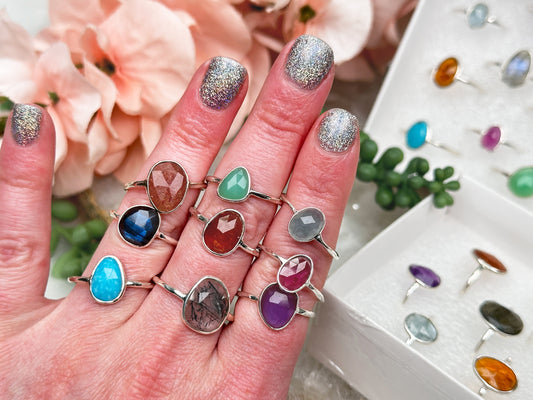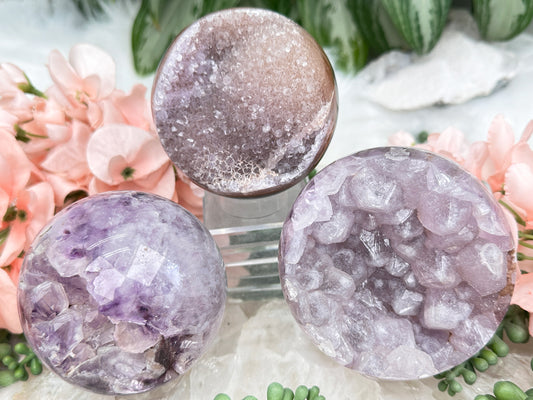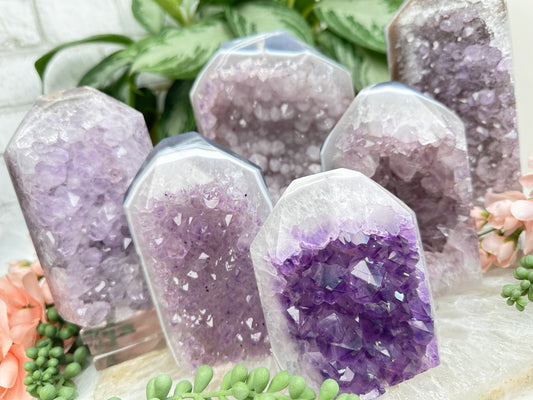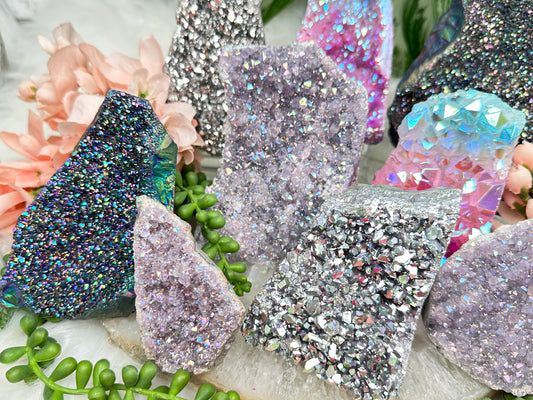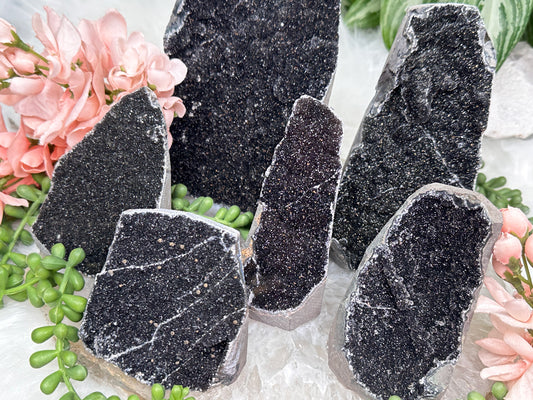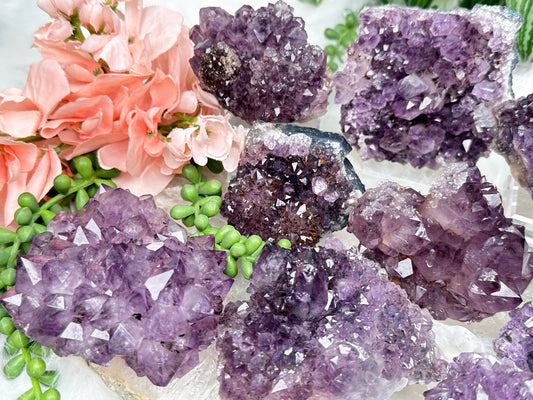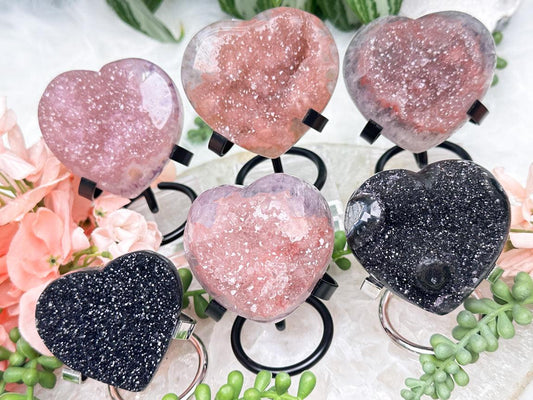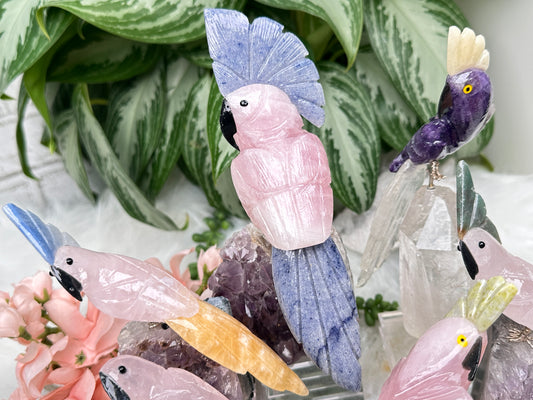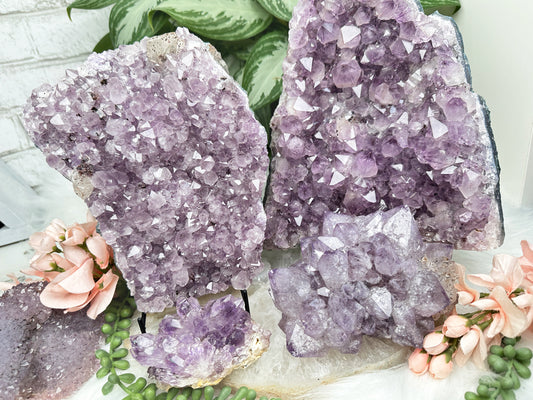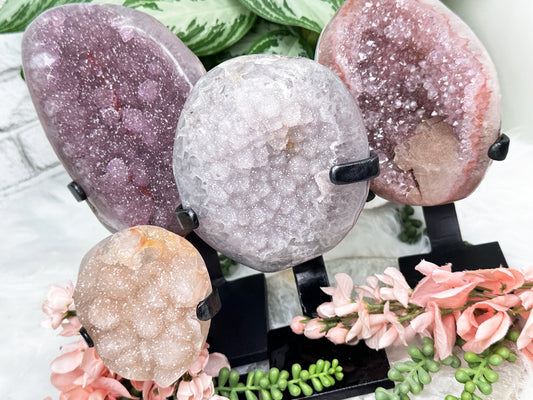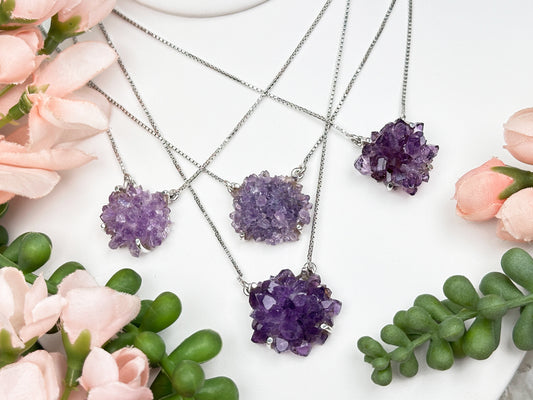Amethyst is a crystal with a range of shades between purple and violet, but it can also come in other varieties. It’s a calming stone and has meditative qualities that offer grounding and tranquility. The amethyst crystal is also known for providing inner healing, spiritual awareness, psychic abilities, positive transformation and communication.
We have a large variety of pieces in many different forms that may include tumbled amethyst, spheres, points, clusters and interesting carvings. We also have some gemstone jewelry for everyday wear and sets that can be the perfect gifts! Read more about amethyst at the bottom of the page!
-
Sterling Silver Faceted Crystal Rings
Regular price $35.00Regular priceUnit price per -
Purple Amethyst Geode Spheres
Regular price $125 - $145Regular priceUnit price per -
Amethyst Cluster Points
Regular price $80 - $150Regular priceUnit price per -
Standing Aura Quartz Clusters
Regular price $18 - $78Regular priceUnit price per -
Black Galaxy Amethyst
Regular price $44 - $245Regular priceUnit price per -
Uruguayan Amethyst Cupcakes
Regular price $38 - $72Regular priceUnit price per -
Amethyst Clusters & Pineapples
Regular price $18 - $33Regular priceUnit price per -
Uruguay Amethyst Hearts
Regular price $68 - $98Regular priceUnit price per -
Amethyst Cathedral Geodes
Regular price $18 - $66Regular priceUnit price per -
Crystal Birds
Regular price $75 - $155Regular priceUnit price per -
Purple Amethyst Clusters
Regular price $18 - $165Regular priceUnit price per -
Uruguayan Amethyst Displays
Regular price $165 - $450Regular priceUnit price per -
Geometric Amethyst Rings
Regular price $72.00Regular priceUnit price per -
Sterling Silver Amethyst Cluster Necklace
Regular price $68.00Regular priceUnit price per -
Quartz & Amethyst Slabs
Regular price $45 - $100Regular priceUnit price per -
Unique Amethyst Crystals
Regular price $14 - $48Regular priceUnit price per -
Pink Purple Amethyst
Regular price $36 - $145Regular priceUnit price per -
Pink Druzy Amethyst Over Calcite
Regular price $48 - $275Regular priceUnit price per -
Amethyst Geodes & Pieces
Regular price $15 - $66Regular priceUnit price per -
Namibia Amethyst Points
Regular price $12 - $22Regular priceUnit price per -
Pink Amethyst & Flower Agate Freeforms
Regular price $46 - $75Regular priceUnit price per -
Ametrine Spheres
Regular price $35 - $48Regular priceUnit price per -
Large Amethyst Calcites
Regular price $30 - $200Regular priceUnit price per -
Crystal Chip Box
Regular price $14.00Regular priceUnit price per

One of the most popular ways to use amethyst is through jewelry. Amethyst is often set in rings, necklaces, bracelets, and crystal earrings, and can be found in a variety of styles, from classic to modern. Its unique purple color makes it a versatile gemstone that can be worn with a variety of outfits, from casual to formal. Amethyst jewelry is also a popular gift for those born in February, as it is the birthstone for that month.
Amethyst Stone
Amethyst is a member of the Quartz family. It is formed and found deep inside igneous volcanic rocks. There needs to be the right environment for them to bloom which includes silica and ferric iron that meet inside the hollowed- out rocks. The traces of iron and other impurities give it that unique very well- known purple coloring we all can recognize. Depending on the components in the mineral, there can also be variations such as Ametrine, Mossy Amethyst, Cape Amethyst and others.
Amethyst crystals get their name from the Greek word “améthystos“ which means “not intoxicated”. This points out that the gemstone is known for encouraging balance, serenity and clarity into the users’ life. According to the Smithsonian, the purple color was given to the amethyst by the God of wine.

It is a silicate mineral. It measures a 7 on the Mohs hardness scale which means it is a hard crystal that is durable. The rock’s surface when fractures appear in the mineral is uneven and conchoidal.
What does Amethyst look like?
Amethyst is a purple variety of quartz crystal found in a light lavender to deep purple coloring in its typical form, but read on for more. Amethyst can range from translucent to opaque, but it is most commonly found as translucent with an opaque base where it had formed in the cracks of a rock or a geode. You can identify Amethyst crystal by its hardness, fractures, shape, and stripes that may be present. But let’s be honest, most people know a classic amethyst when they see it! : )
This crystal has conchoidal fractures (circular fractures that look like ripples in water) when a large raw chunk is broken. When looking into the gem, you may see a feather or fingerprint pattered texture inside of the stone. Amethyst has a hexagonal crystalline structure, meaning that it will always have six sides. It is typical to find amethyst with phantoms, growth patterns with an ombre hue, and even chevron lines.
Different Types of Amethyst

Amethyst, a member of the quartz family, exhibits a captivating range of hues, and its various types offer diverse visual and metaphysical experiences. Here are just some of the different types of amethyst. The most renowned type is the deep purple Amethyst, with shades ranging from pale lavender to rich violet. Green Amethyst, also known as Prasiolite, is a rare variation resulting from the exposure of Amethyst to heat, which imparts a lovely green hue. Chevron Amethyst showcases striking banded patterns, often resembling chevrons or v-shapes, and combines the energetic properties of both Amethyst and White Quartz.
Vera Cruz Amethyst, sourced from Mexico, is celebrated for its clarity and pale lavender coloring. Brandberg Amethyst, found in Namibia, boasts a unique blend of Amethyst and Smoky Quartz, creating a beautiful violet-brown crystal. Spirit Quartz, sometimes referred to as Cactus Quartz, is recognized for its clusters of small Amethyst points growing on a central crystal, emanating an enchanting and harmonious energy. These diverse varieties of Amethyst crystals cater to a wide spectrum of tastes and spiritual needs, making Amethyst a beloved gemstone in the world of crystal enthusiasts and collectors.
What crystals grow with Amethyst?

Many actually! Amethyst crystals can also contain a variety of other minerals and crystals, some of which can create stunning visual effects. Goethite and Hollandite are two minerals that are commonly found growing on or inside purple amethyst crystals, creating beautiful and unique formations. Goethite is a mineral that often forms in fibrous, needle-like structures that can appear as golden-brown hair-like strands growing on or within amethyst crystals. Hollandite, on the other hand, forms as black, platy crystals that grow near the surface of amethyst and often look like little black furballs. Similarly Siderite can grow on and in amethyst and will either be a sparkle tan-orange hue botryoidal formation on top, or a white-tan dot under the surface.
Amethyst often grows in geodes, which are hollow rock cavities lined with inward-facing crystals. Inside these geodes, various other minerals can grow on or within the amethyst crystals, creating unique and beautiful patterns. One mineral commonly found with amethyst is calcite crystal, which can form small, transparent crystals or cloudy, opaque masses. Quartz and citrine are also known to grow with amethyst, as well as other types of minerals like smoky quartz and agate. These inclusions can greatly enhance the beauty and value of an amethyst crystal, and are highly sought after by collectors and enthusiasts. Additionally, the presence of these minerals can also affect the energy and metaphysical properties of the amethyst, creating unique combinations of healing properties.
Purple amethyst can also include iron and hematite which will also cause a variety of colors from yellows to pinks to blacks.

Amethyst Color
What Color Is Amethyst?
Amethyst, a mesmerizing member of the quartz family, boasts a rich purple hue that captivates the senses. This enchanting coloration is a result of a fascinating combination of factors, including irradiation, as well as the presence of impurities within the crystal's structure. These impurities, such as iron, hematite, chlorite, and even minerals like rutile and cacoxenite, contribute to the intricate tapestry of colors that amethyst can display. While the primary purple tone remains its hallmark, amethyst's ability to incorporate a diverse range of inclusions introduces a captivating array of subtle color variations.

In addition to iconic purple amethyst, it can exhibit hints of red, pink, green, brown, gray or black within its gem. These secondary colors interplay with the dominant purple, creating intriguing shades such as a soft gray reminiscent of an overcast sky or a delicate pink that evokes a sense of serenity. This remarkable diversity in amethyst's color palette makes each specimen a unique work of art, adding to its allure and versatility. Whether you are drawn to the classic purple amethyst or one of its enchanting variations, each variation holds its own charm and resonates with different aspects of the human spirit.
There are also unique healing properties for the other variations of colors:
Red Amethyst
Red inclusions in amethyst can bring additional grounding and vitality to the crystal's properties. It is believed to boost physical energy, stimulate passion and motivation, and improve circulation. Red amethyst can be useful for those seeking more vitality and strength in their lives.
Green Amethyst
Green amethyst is associated with the heart chakra and is known for promoting emotional healing, compassion, and self-acceptance. It can assist in releasing old emotional wounds and fostering love and understanding in relationships.

Gray Amethyst
Gray amethyst carries a soothing and calming energy. It can help with emotional balance, reducing anxiety, and enhancing mental clarity. Gray amethyst is often used for grounding and centering during meditation.
Black Amethyst
Black inclusions in amethyst may provide additional protection and grounding properties. It is believed to shield against negative energies and enhance spiritual growth. Black amethyst can be used for purification and transformation.
Raw Amethyst
Raw amethyst, with its unrefined beauty, offers a unique connection to the Earth's elemental forces. This unprocessed form of the crystal showcases its rugged charm, presenting itself in a variety of growth patterns. From robust and primal chunks that emanate raw energy to the delicate twinkle of tiny druzy clusters resembling a starry night, raw amethyst's appeal is undeniable. For those who seek a more commanding presence, chunky point formations exhibit layers of crystal that seem to hold the wisdom of the ages.
Additionally, when raw amethyst remains untouched by cutting or polishing, it can create captivating stalactites or intriguing "eyes," resembling ancient cosmic gateways. This remarkable diversity in raw amethyst's appearance makes it a coveted gemstone for an array of purposes. Whether it finds its place in your jewelry collection, rests in your pocket as a grounding talisman, or graces your sacred meditation space, raw amethyst remains a versatile and cherished companion on your spiritual journey, connecting you to the primal energies of the Earth.
Where does Amethyst come from?

A very common crystal that can be found all around the world, mainly in South and North America as well as Africa. One of the biggest deposits were discovered in Brazil which is still the largest global producer today. Some other places where this crystal might be found are Uruguay, India, Greece, Italy and the Middle East.
Amethyst crystal, a stunning purple variety of quartz, grows beneath the Earth's surface in a variety of captivating formations. It typically forms in geodes, which are spherical cavities lined with crystals. These geodes can vary in size from a few inches to several feet in diameter. Inside, Amethyst crystals develop in various structures, such as cathedral or castle-like formations, where tall, pointed crystals grow within the geode, creating an otherworldly appearance. Amethyst can also form as stalactites and stalagmites in caves, resembling icicles of purple crystal.
Additionally, it can be found as massive deposits or clusters of smaller crystals. The formation of Amethyst crystals depends on factors like temperature, pressure, and the presence of iron and other trace elements, which contribute to its distinct shades and crystalline structures. Regardless of the formation, Amethyst's exquisite beauty and metaphysical properties have made it a cherished gemstone among crystal enthusiasts and spiritual practitioners for centuries.
What does amethyst do?
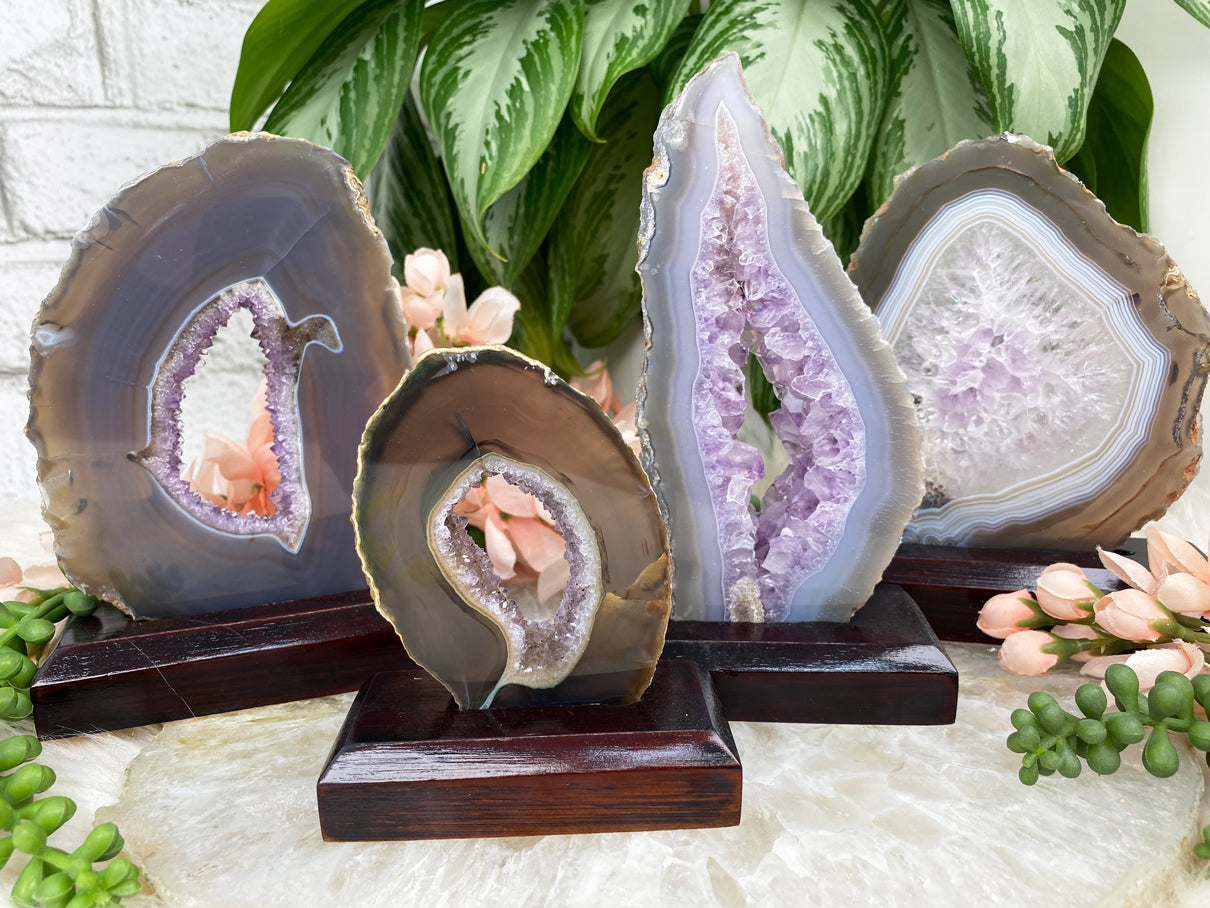
The Amethyst meaning is known for its calming energy which will soothe and bring balance into your life. So other than that, what does amethyst do?
Amethyst crystal is a multifaceted crystal renowned for its profound healing properties and metaphysical significance. It serves as a calming influence, making it an exceptional choice for individuals grappling with racing thoughts, anxiety, and emotional turbulence. Amethyst meaning and soothing energy promotes mental clarity and inner peace, helping one find respite from the chaos of everyday life.
One of Amethyst's most celebrated attributes is its ability to enhance psychic awareness and intuition. By connecting with the Crown Chakra, it opens a gateway to higher consciousness, allowing individuals to tap into their inner wisdom and spiritual insights. This connection to the metaphysical realm can aid in making more informed decisions and navigating life's complexities with greater ease.
Amethyst also shines as a crystal for improving sleep patterns. Placing an Amethyst cluster or tumbled stone under your pillow can promote restful and rejuvenating sleep, making it an excellent companion for those struggling with insomnia or restless nights.

Beyond its emotional and spiritual benefits, Amethyst meanings are believed to alleviate stress, anger, irritability, fear, and anxiety. Its harmonious energy uplifts the atmosphere, making it a popular choice for placing in various areas of the home to maintain positive vibes and encourage a cheerful ambiance.
Crystals That Work Well With Amethyst
Amethyst, with its soothing and transformative energy, harmonizes exquisitely with various unique crystals, creating powerful synergies for personal growth and healing. Combining Amethyst with Black Schorl Tourmaline forms a protective shield, grounding and purifying negative energies. Pairing Amethyst with Fluorite enhances mental clarity, intuition, and spiritual awareness, facilitating profound inner exploration. Amethyst and Lepidolite crystal work in tandem to alleviate stress, anxiety, and promote emotional balance and tranquility. When purple Amethyst is combined with Rhodonite, it fosters self-love, compassion, and emotional healing, encouraging forgiveness and opening the heart to new possibilities. The synergy of Amethyst and Blue Lace Agate nurtures clear communication, calming the mind and promoting peace within relationships. These unique crystal combinations offer diverse and powerful energetic support, elevating the healing potential of Amethyst to new heights.
How to use amethyst in Feng Shui
Amethyst holds a special place in the practice of Feng Shui, the ancient Chinese art of harmonizing energy in our living spaces. This exquisite purple crystal is associated with the Water element and carries a gentle, soothing energy that makes it a valuable addition to any Feng Shui arrangement.
In Feng Shui, amethyst stone is often used to create a sense of calm and balance within a space. Its tranquil energy makes it an ideal choice for bedrooms, meditation areas, and spaces where relaxation is a priority. Placing amethyst in these areas can help promote restful sleep, enhance meditation practices, and create an atmosphere of serenity.
Amethyst is also linked to the Crown Chakra, which is associated with spirituality and higher consciousness. This makes it a valuable tool for enhancing spiritual growth and deepening one's connection to the divine. In Feng Shui, amethyst can be strategically placed in areas where you seek spiritual insight and wisdom.
Furthermore, amethyst crystal is believed to have a purifying effect on the energy of a space. It can help dispel negativity and promote a sense of clarity and balance. Placing amethyst clusters or geodes in central areas of your home can act as energetic anchors, helping to maintain a harmonious environment.
Overall, amethyst's calming, spiritual, and purifying qualities make it a versatile and valuable addition to Feng Shui practices, allowing you to create spaces that promote well-being, tranquility, and spiritual growth.
Amethyst Birthstone
Amethyst, the captivating purple gemstone, takes its place as the birthstone for the month of February. With its stunning violet hues, amethyst is not only aesthetically pleasing but also carries a rich history of symbolism and significance. Often associated with qualities such as tranquility, inner peace, and spiritual awareness, amethyst aligns perfectly with the introspective and contemplative energies of the winter month it represents. Those born in February are believed to receive the calming and balancing effects of amethyst, promoting mental clarity and emotional harmony. Whether worn as jewelry or kept as a talisman, the amethyst birthstone serves as a beautiful reminder of the potential for personal growth and serenity that this birthstone embodies.
Amethyst is also the Pisces birthstone.
Amethyst Jewelry
Wearing amethyst jewelry offers a multitude of benefits tailored to enhance your well-being and style simultaneously. The exquisite purple hues of amethyst jewelry not only add elegance to your look but also infuse your life with positive energies. When adorning amethyst jewelry, you carry with you a calming influence that helps alleviate stress and anxiety, fostering a sense of inner peace and serenity.

Beyond its aesthetic appeal, amethyst jewelry is your spiritual companion. It can deepen your meditation practice, promote spiritual awareness, and enhance your intuition. The jewelry's connection with the Third Eye and Crown Chakras facilitates spiritual growth and inner wisdom, allowing you to stay connected to your higher self throughout the day.
Amethyst jewelry serves as a protective shield, warding off negative energies and psychic attacks, ensuring that you move through your day with a sense of security and positivity. Moreover, it promotes restful sleep and vivid dreams when worn before bedtime, ensuring you wake up feeling refreshed and rejuvenated.
In essence, amethyst jewelry combines beauty and purpose, offering you both a stylish accessory and a source of tranquility, spirituality, and protection throughout your daily journey.
More about Amethyst
Amethyst is a 7 on the Mohs hardness scale, meaning that it is as hard or harder than steel. A HUGE percentage of amethyst comes from Brazil, likely second from Uruguay. They account for the most commonly recognized amethyst clusters that you see out and about.
Chakra: Third Eye and Crown
Localities: South Korea, Russia, Austria, Brazil, Uruguay, Africa, The United
States, India and Madagascar
Birthstone: February

Curious about Chevron Amethyst specifically ? Check out that page too! There is also another form of amethyst known as pink amethyst which you can read about on its own page. The different types of amethyst are equally amazing!


